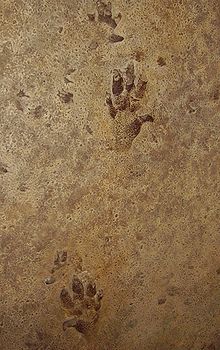- Chirotherium
-
Chirotherium
Temporal range: 243 MaCheirotherium trace fossil, displayed in Oxford University Museum of Natural History Trace fossil classification 
Ichnoclass: Reptilipedia Ichnofamily: Kaup, 1835 Type ichnospecies C. barthii
Kaup, 1835Ichnospecies - C. barthii Kaup, 1835
- C. sickleri Kaup, 1835
- C. stortonense Morton, 1863
- C. vorbachi Kirchner, 1927
- C. beasleyi Peabody, 1948
- C. moquinense Peabody, 1956
- C. rex Peabody, 1948
- C. lulli Bock, 1952
- C. wondrai Heller, 1952
- C. swinnertoni (Sarjeant, 1970)
- C. courelli DeMathieu, 1970
- C. atlensis Biron & Dutuit, 1981
- C. mediterraneum DeMathieu & Durand, 1991
Synonyms Chirotherium, also known as Cheirotherium ('hand-beast'), is the name of a Triassic archosaur known only from fossil imprints of its tracks (trace fossils). These look, by coincidence, remarkably like the hands of apes, humans, and bears, with the outermost toe having evolved to extend out to the side like a thumb, although probably only functioning to provide a firmer grip in mud. Its tracks were first found in 1834 in red sandstone in Thuringia, Germany, dating from about 243 million years ago (mya).
This creature was probably a pseudosuchian archosaur related to the ancestors of the crocodiles. It likely belonged to a group of pseudosuchians called the rauisuchians, which were large carnivores with erect gaits.
Contents
History
Chirotherium tracks were first found in German Triassic sandstones in 1834, and later in England in 1838. Tracks left by this creature were found before dinosaurs were known and initial models of the animal proposed that it was a bear or ape, which walked with its feet crossed.[1] This proposal was necessary to explain the toe on the outside. The tracks were also proposed to be from a marsupial.[2] These fossil tracks have now been found on North America, Africa, and Europe.
British paleontologist Richard Owen suggested in 1842 that the tracks were made by a labyrinthodont amphibian.[2] Over the following years, new discoveries of archosaurian reptiles indicated that Chirotherium tracks were made by a pseudosuchian. The print's resemblance to mammals was only superficial; in reality, an external (lateral) 'thumb' was commonplace among Triassic archosaurs.
 Chirotherium monument with the reconstruction of a tracksite in Hildburghausen, Germany, where the first tracks were found in 1833.
Chirotherium monument with the reconstruction of a tracksite in Hildburghausen, Germany, where the first tracks were found in 1833.
In 1965, the skeleton of a probably closely related animal was found, called Ticinosuchus.[2] It had the external toe on its hind feet but not on its front feet and was possibly a more advanced descendant, whose gait had improved enough to reduce the need for a stabilizing front toe. Chirotherium barthii and Ticinosuchus ferox have also been proposed to be the same species, with what may have been a gender difference (sexual dimorphism) visible in the tracks.[3]
Paleobiology
Chirotherium trackways have been found in German sandstones that were likely deposited along shorelines. During the Triassic, much of Europe was a chain of islands surrounded by the shallow Tethys Ocean. In one location, Chirotherium trackways were found alongside those of early horseshoe crabs. The horseshoe crabs were likely breeding along the intertidal zone while the Chirotherium track maker preyed on them during low tide. Smaller reptiles like Macrocnemus, represented by the ichnogenus Rhynchosauroides, likely fed on the horseshoe crabs' eggs.[4]
See also
References
- ^ Swinton, W.E. (1961). "The history of Chirotherium". Geological Journal 2 (3): 443–473. doi:10.1002/gj.3350020309.
- ^ a b c Bowden, A.J.; Tresise, G.R.; and Simkiss, W. (2010). "Chirotherium, the Liverpool footprint hunters and their interpretation of the Middle Trias environment". Geological Societ, London, Special Publications 343: 209–228. doi:10.1144/SP343.12.
- ^ Tresise, G. (1996). "Sex in the footprint bed". Geology Today 12 (1): 22–26. doi:10.1046/j.1365-2451.1996.00005.x.
- ^ Diedrich, C.G. (2011). "Middle Triassic horseshoe crab reproduction areas on intertidal flats of Europe with evidence of predation by archosaurs". Biological Journal of the Linnean Society 103 (1): 76–105. doi:10.1111/j.1095-8312.2011.01635.x.
Categories:- Trace fossils
- Fossil trackways
Wikimedia Foundation. 2010.

